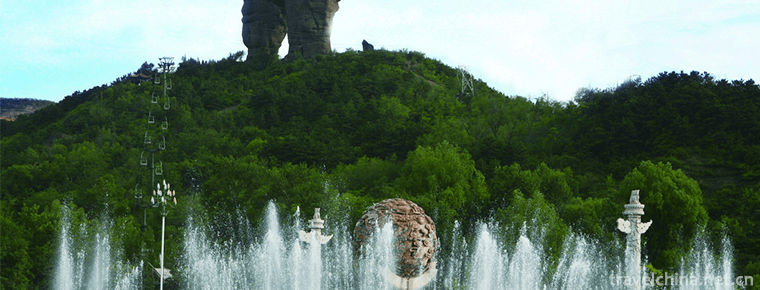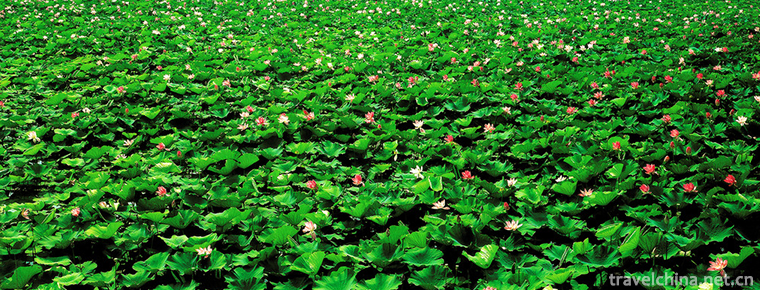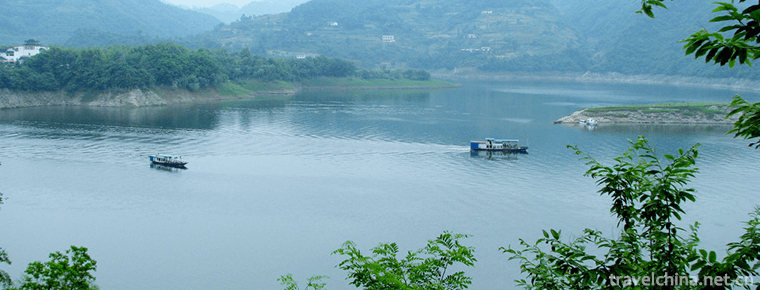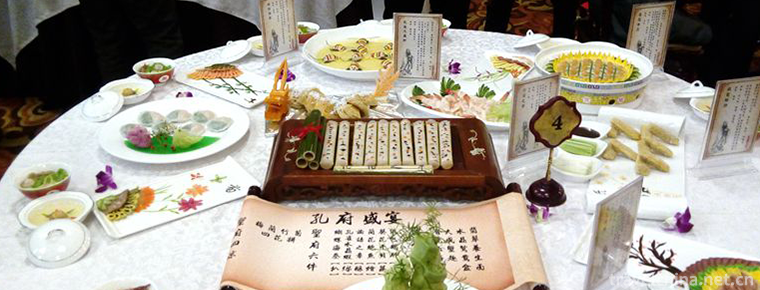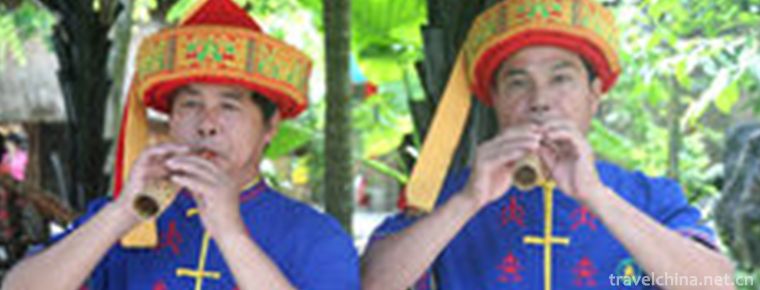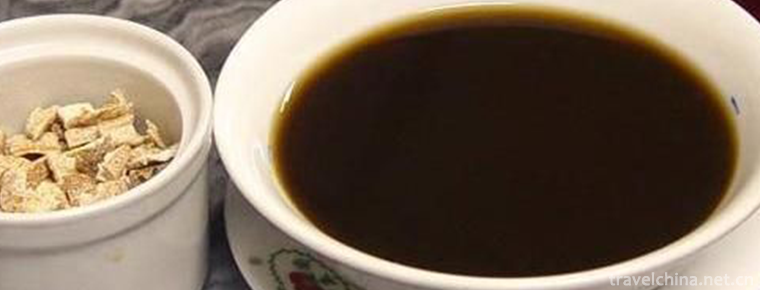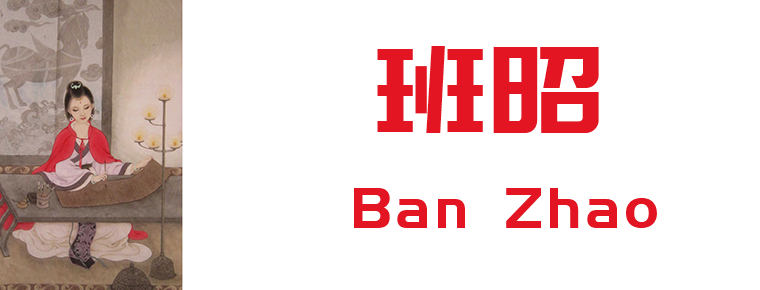Yuelu Mountain and Orange Prefecture Tourist Area
Orange Island Scenic Area is located in the heart of the Xiangjiang River opposite Changsha City, Hunan Province. It is the largest famous island in the Xiangjiang River with an area of 91.4 hectares. From south to north, across the heart of the river, West to Yuelu Mountain, east to Changsha City, surrounded by water, stretching for more than 10 miles, narrow about 40 meters across, wide about 140 meters across, the shape of a long island, is a key national scenic spot.
The development and construction structure of Orange Island Scenic Area is planned as "one axis and four districts", and the four districts are core scenic spots, tourism supporting service areas, beach parks and water sports areas.
In August 2016, the State Tourism Administration decided to delist the Orange Island Scenic spots which seriously failed to meet the standards. It is the second batch of delisted scenic spots in China. On December 18, 2017, the National Tourism Resources Planning and Development Quality Assessment Committee organized an expert group to review and decided to restore the quality level of the national 5A-level tourist attractions in Orange Island scenic spot from now on.
Historically recorded Orange Island was formed in Yongxing 2 years (305) of Emperor Huidi of Jin Dynasty. It was formed by torrential cycles and sand and stone accumulation. The original four islands of Juzhou, Zhizhou, Oath Island and Quanzhou were only Shangzhou, Zhongzhou and Xiazhou in the Qing Dynasty. Today it has evolved into a series of long islands, with Niutouzhou on the top, Shuilu on the middle and Fujiazhou on the bottom. Orange Island is famous for its rich oranges. The flow of Xiangjiang River is gentle and its bed is wide. Oasis patches are formed because the lower reaches are supported by the water top of Dongting Lake. Orange Island is well-known for a long time, spring, bright light, sand gulls dot; autumn solstice, grapefruit yellow orange red, fragrant; deep winter, ice shearing, river wind and snow, is one of the eight sceneries in Xiaoxiang, "river evening snow" location. After 1904, Changsha was opened to the outside world as a commercial port, with the British Consulate and the New Pass in Changsha built on the continent.
In 1925 (14 years of the Republic of China), Comrade Mao Zedong returned from Guangzhou to Hunan to lead the peasant movement. In the cold autumn, he revisited Orange Island and wrote "Qinyuan Chun Changsha". As a result, Orange Island gained a great reputation.
In May 1950, Premier Zhou and Chairman Mao made a couplet. The couplet was "Orange Island, the boat beside the continent, the boat does not leave the continent", and the couplet was "Tianxin Pavilion, the pigeon in the pavilion, the pigeon does not fly in the pavilion".
In 1960, Juzhou Park was built in Zhoutou, covering an area of 14.2 hectares. A special branch bridge was built from the Xiangjiang River Bridge to the island. The embankment is enclosed with stone fences and protected by weeping willows. The Pavilion and corridor of the Wangjiang River in Zhoutou are facing a huge monument of white marble with four big characters in Chairman Mao's handwriting "Orange Island Head" and the word "Independent Cold Autumn, Xiangjiang North, Orange Island Head" in the word "Qinyuan Spring Changsha" written by Chairman Mao in the autumn of 1925. There are thousands of citrus plants on the continent. In the golden autumn season, there are many orange fruits. The two lakes under the continent are measured as flat beaches. They are natural swimming places. Every midsummer, people go together and play in the water to cool off the heat. Orange Island is about 6 kilometers long in North and South and 0.5 kilometers wide in East and west. At the end of Orange Island, the water is clean and the sand is clear, opening up a natural swimming pool. Orange Island Head, a vast area of the Yangtze River, has built a beautiful Orange Island Park. The giant Han Baiyu Monument standing in the center of the park is particularly striking, with Mao Zedong's handwriting "Orange Island Head" engraved on the front and Qinyuan Spring Changsha on the back. In Zhoutou, there is also a pavilion with national characteristics, flying over the Xiangshui River.
It was established as Orange Island Park in 1961 and opened to the outside world in 1962. In 1998, it was renamed Orange Island Scenic Spot of Yuelu Mountain Scenic Spot. The total area of the original scenic spot is about 17 hectares, and the area of the open area is about 6 hectares. The main scenic spots are Zhoutou Song Orange Pavilion, Han Baiyu Poetry and Ci Stele, Bronze Statue Square, Rattan Plaza, Chairman Mao's trip to Xiangjiang Memorial Site, Lanyue Pavilion, Pillow River Pavilion, Bonsai Garden, Gate Square, etc.
In 2001, it was renamed Orange Island Scenic Spot of Yuelu Mountain Scenic Spot in Changsha. Covering an area of 17 hectares, there are poetry tablets, orange pavilions and "Who is the main ups and downs" sculpture plaza and other scenic spots, which are scenic spots in Hunan Province. The Orange Island Head Folk Culture Park in Changsha consists of four parts: Qianjie Temple, Jiangshen Temple, Shuiyuetang Temple and Arch Tower. The Jiangshen Temple was first built in Liang Dynasty of the Six Dynasties. It was named Shuilu Temple. It was a primitive Buddhist temple. During the eight years of Yongzheng in Qing Dynasty, Emperor Yongzheng ordered Jiangnan provinces to "sacrifice Jiangshen to benefit Zhouzheng", so Zhao was deployed as an ambassador in Hunan Province. The City presided over the change from Shuilu Temple to Jiangshen Temple. For more than two hundred years, residents and fishermen on Orange Island often went back to the temple to burn incense and pray for peace.
In 2004, the Changsha Municipal Committee and the Municipal Government decided to upgrade the quality of Orange Island. After more than four years of hard work by the construction engineers, a blue hairpin sleeping wave, torrential rushing green, though made by human beings, is presented to the world.
In August 2016, the State Tourism Administration decided to delist the Orange Island Scenic spots which seriously failed to meet the standards. It is the second batch of delisted scenic spots in China.
On December 18, 2017, the National Tourism Resources Planning and Development Quality Assessment Committee organized an expert group to review and decided to restore the quality level of the national 5A-level tourist attractions in Orange Island scenic spot from now on.
Yuelu Mountain Scenic Area is located in Yuelu District of Changsha City, Hunan Province, with an elevation of 300.8 meters and an area of 35.20 square kilometers. It is the last peak of 72 peaks in Hengshan Mountain of Nanyue. It is located in Orange Island Scenic Area. It is a City mountain scenic spot and one of the four Maple scenic spots in China.
Yuelu Mountain is located on the West Bank of Xiangjiang River in Changsha City, the first batch of famous national historical and cultural cities. It is on the market according to the river. There are four core scenic spots: Yuelu Mountain, Orange Island, Yuelu Academy and Xinmin Society. It is a rare national AAAAA-level scenic spot, national key scenic spot and Huxiang Cultural Communication which integrates mountains, waters, continents and cities. Base and demonstration base of patriotic education.
Yuelu Mountain was named for "800 miles around Nanyue, headed by Huiyan and footed by Yuelu" in Nanyue Records of the Southern Song Dynasty. It integrates Confucianism, Buddhism and Taoism, which are the essence of Chinese ancient culture. It contains the cultural connotation of Yuelu Mountain, which was jointly developed by the great thinkers, monks and poets. There are Yuelu Academy, Aiwanting Pavilion, Lushan Temple, Yunlu Palace, the old site of Xinmin Society, Huangxing Tomb, Cai Yong Tomb, and the old site of Wartime Command of the Ninth War Zone Command.
In January 2012, Yuelu Mountain Scenic Spot was announced as the national AAAAA-level tourist attraction by the National Tourism Administration.
Yuelu Mountain has a unique geographical location. Yuelu Mountain belongs to Hengshan Mountain of Nanyue. The ancients listed Yuelu Mountain as the last peak of the seventy-second peak of Nanyue, which is called Linglu Peak. It is 102 kilometers away from Zhurong Peak, the main peak of Hengshan Mountain in the south. Long ago, in Liu Song Dynasty of the Southern and Northern Dynasties, Nanyue Ji recorded that "800 Li around Nanyue, Huiyan is the leader, Yuelu is the foot of the foot." It's called Yuelu. According to geological textual research, Yuelu Mountain was founded in the Paleozoic, formed in the Mesozoic and developed in the Cenozoic, more than 300 million years ago.
Main attractions
Love Pavilion
Aiwanting was founded in 1792 by Luo Dian, Dean of Yuelu Academy, in the fifty-seventh year of Qianlong in Qing Dynasty. The four famous pavilions in China are the Drunken Weng Pavilion (1046) in Chuxian County of Anhui Province, the Huxin Pavilion (1552) in West Lake of Hangzhou and the Taoran Pavilion (1695) in Taoran Pavilion Park of Beijing.
Aiwanting Pavilion was originally named Hongyeting Pavilion, also known as Aifeng Pavilion. Later by Huguang Governor Bi Yuan, according to Du Mu, "far up the cold mountain stone path inclined, deep in the Baiyun has a family. The poem "Parking in Love Maple Forest Late, Frost Leaves Red in February Flowers" was renamed "Love Evening Pavilion". After several vicissitudes of life, the pavilion was restored in Tongzhi, Guangxu and Xuantong years of the Qing Dynasty. In the autumn of the third year of Xuantong, when Cheng Songwan, the supervisor of Hunan University, presided over the restoration, he inscribed the couplets written by Luo Dian on the pavilion pillars, "The mountain path is late and red, five hundred young peaches are newly planted; the clouds of the Gorge are deep and green, and a pair of trained cranes are waiting to be caged". The restoration of the love evening Pavilion is also inscribed on stone tablets. People in the world call it "Fanghe" stone carving or "Ernan Poetry Carving". The two poems are the seven-rhyme poems of Zhang Nanxuan in Song Dynasty and Qian Nanyuan in Qing Dynasty. The stone carvings were moved to the hexagonal pavilion at the southern end of Qingfeng Bridge. Before liberation, the pavilion was in ruins and desolate surroundings. After liberation, the Party and the government had been restored five times. In 1952, when Hunan University was renovated, President Li Da wrote to Mao Zedong to inscribe the pavilion of "Love Evening Pavilion". In 1969, Yuelushan Park was rebuilt and Mao Zedong's cursive handwriting Qinyuan Spring Changsha was engraved in the algae well, adding luster to the ancient pavilion. In international exchanges, the popularity of Evening Pavilion is also increasing. After Changsha became a friendly city with Kagoshima, Japan, Aiwanting Pavilion, as the symbol of the ancient city Changsha, was modeled in Kagoshima according to its regulations to commemorate the lasting friendship between the Chinese and Japanese people. When Mao Zedong was young, he studied in Changsha No. 1 Normal University. He often joined Luo Xueyan and Zhang Kundi in Yuelu Academy. He met Cai Hesen and loved the evening pavilion. He talked about the current situation and sought truth. For this reason, Li Da, president of Hunan University, wrote to Mao Zedong in 1952 when he restored his love evening pavilion. He asked for the name of the pavilion. Mao happily accepted the request.
Yuelu Academy
One of the four famous academies in ancient China is also one of the best preserved ancient academies in China.
Yuelu Academy is located in Yuelu Mountain Scenic Area, a national AAAAA-level tourist attraction on the West Bank of Xiangjiang River in Changsha City, Hunan Province. In the ninth year of Kaibao in the Northern Song Dynasty (976 A.D.), Taishou Zhudong in Tanzhou formally founded Yuelu Academy on the basis of monks'school-running. Later, after the Song, Yuan, Ming and Qing dynasties, in the end of the Qing Dynasty, Guangxu 29 (1903 AD) was transformed into Hunan Higher Education School, then Hunan Normal University and Hunan Industrial School, which were officially named Hunan University in 1926. After thousands of years, chorus song is endless. It was called "Millennium Academy" in the past.
Yuelu Academy covers an area of 21,000 square meters. Most of the existing buildings are relics of Ming and Qing Dynasties. The main buildings include gates, two gates, lectures, semi-study halls, teaching halls, Baiquan Xuan, imperial library, classical halls of Xiangshui School, and literary temples. All the parts are connected to each other, which fully shows the magnificent scene of ancient Chinese architecture. In addition to architectural relics, Yuelu Academy is also famous for preserving a large number of monuments and cultural relics, such as Tang Dynasty inscribed "Lushan Temple Monument", Ming Dynasty inscribed "Yuelu Academy" stone monument, Chengzi four monuments, Qing Dynasty imperial plaque "learning to reach nature", "Daonan Zhengmai", Qing Dynasty inscribed Zhuxi "loyalty, filial piety and honesty monument" and Ouyang Zhenghuan "neat and orderly". Serious Stele, Wang Wenqing's Stele of Yuelu Academy's School Regulations, etc. The ancient buildings of Yuelu Academy are divided into five architectural patterns: teaching, collecting books, offering sacrifices, gardens and memorials.
Note: Yuelu Academy, Bailudong Academy, Songyang Academy and Yingtian Academy are the four major academies in ancient China.
Lushan Temple
Lushan Temple, also known as "Yuelu Temple", "Huiguang Temple", "Luyuan" and "Wanshou Temple", is located in the Bixu Mountain of Yuelu Mountain on the West Bank of Xiangjiang River in Changsha City, Hunan Province. In front of the temple is Qingfengxia, which is the foot of Hengshan Mountain in Nanyue, which extends to Changsha. So it is called Yuelu. It is one of the seventy-two peaks in Nanyue, with an elevation of 295.7 meters and an area of about 8300 mu.
Lushan Temple is an ancient temple in the early Jin Dynasty. It is the earliest large temple in Hunan for Buddhism. The Ming Shenzong Temple was renamed Longevity Temple, renamed in the early years of the Republic of China, and the Ancient Lushan Temple.
Du Fu, a great poet of the Tang Dynasty, once praised the magnificence of the temple by saying that the gate of the temple was high and the court was open and the foot of the temple was inserted into the Chisha Lake. Daxiong Baodian and other major buildings were destroyed in 1944, only Shanmen and Guanyin Pavilion were left, and now they have been renovated. There is a banner of "Gulushan Temple" on the mountain gate, which is flanked by "the original scenic spots of Han and Wei Dynasty, the first stage of Huxiang" couplets, ancient maple trees outside the gate, covered with thick shade, and hundreds of flowers competing for beautiful Guanyin Pavilion in the garden inside the gate is a brick-wood structure, 1955. It was repaired and restored to its original appearance in 1980, and Guanyin image was placed in the hall shrine. Yan Nei often holds small exhibitions of calligraphy and painting.
Yun Lu Palace
At the peak of Yuelu. It is the twenty-third hole of Taoism. Founded in the fourteenth year of Chenghua Ming Dynasty (1478 AD) and Jiajing (1522 - 1566 AD), Changsha Taishou Sun Fu and Taoist priest Li Ke presided over the renovation. In the sixth year of Longqing (1572 AD), Zhang Dianyuan was rebuilt. At that time, the imperial palace, Xuanwu ancestor palace and Sanqing palace entered three directions, and were destroyed in the war at the end of Ming Dynasty. In the fifteenth year of Chongzhen (1642 AD), the ancestral temple was rebuilt. The four years of Kangxi in Qing Dynasty (1665 AD) and the eight years of Jiaqing (1803 AD) were renewed twice. In the thirteenth year of Daoguang (1833 AD), Governor Wu Rongguang and Ambassador Huifeng rebuilt the front hall. In 1852, Xianfeng was destroyed by soldiers. In the second year of Tongzhi (1863 AD), Taihe officials and Taoists in Wudang Mountains raised funds from Jiaohui for reconstruction.
In the 1940s, it was seriously damaged by the Japanese army. After the victory of the Anti-Japanese War, Taoist priests Wu Yunkai and Wu Haiming raised funds to repair it. Existing Lv Zu Dian, Zu Shi Dian, Sanqing Dian into three. Luzu Palace was built with the true image of the Han Baiyu relief of Luzu Xianshi and carved with the inscription of 100 characters. The palace was repaired in the 1980s and opened to the public formally in the spring of 1989. There are three statues of Emperor Guan in the front hall and three statues of Yin in the Three Qing Dynasties according to Taoist regulations.
Former site of Xinmin Institute
The old site of Xinmin Founding Association and Cai Hesen's former residence is located in Xinmin Road, Liangwan Town, Changsha City, north gate of Yuelu Mountain in the West and West Bank of Xiangjiang River in the east. It was announced by Hunan Provincial People's Government as a provincial cultural relic protection unit in 1983 and rebuilt in 1987 according to its original appearance. Comrades Deng Xiaoping and Chen Yun inscribed "Cai Hesen's former residence" and "the old site where the New People's Society was founded".
The core protection area of the old site is about 5000 square meters. It is a Qing Dynasty farmhouse with small green tiles, wooden bents and bamboo weaving wall structure. It is surrounded by bamboo fences, camphor and camphor. There are ancient wells, slots and cemeteries of Zhou Dynasty. The newly-built exhibition room displays the three-year history of Xinmin Society in the form of scene reproduction and relief. It highlights the group image of Huxiang proletariat pioneer with the elite image of 74 members. It has become an important place for young people and the masses to receive revolutionary traditional education. It is an educational base and tourist attraction that integrates humanistic landscape and natural landscape.
Stupa
In the early years of the Republic of China, Buddhist children searched for the original site of the pagoda and rebuilt the stone pagoda. At the beginning of the founding of the People's Republic of China, the Shrine Pagoda was renovated, all made of granite. It looks like a monk's cap. The pagoda is divided into three layers: the base of the pagoda is the base of the pagoda; the middle four corners are the shape of banana leaves; the relief statues are five, which contain the meaning of guarding the pagoda; and the top of the upper layer is like the top of the monk's cap. There are stone tablets in the western part of the pagoda. The inscription of Sui Shri Pagoda on the front of the pagoda is handsome. Stele Yin has stone carvings of "building Bodhisattva together", which means "awakening" in Buddhist language.
Yu Wang tablet
The monument of King Yuyu in Yuelu is 1.7 meters high and 1.4 meters wide. The inscription is divided into nine lines, each line has nine words, totaling 77 words, and the last line is empty. Its characters, like tadpoles, are not only different from Oracle bones, bells and tripods, but also from tadpoles in Quwen. They are difficult to identify. They may be a kind of Taoist catalogue, or they are forged by Taoists. But more than 1200 years ago, Han Yu heard of it. He also visited the Yubei tablet in Jianjianfeng, Nanyue, and left a poem record. Even the fake articles in Tang and Song Dynasties are very precious as monuments commemorating Dayu's water control. There are more than a dozen Yuyu steles in China, all of which are reproduced by Yuelu stele model.
He Xi Tai
Hexitai is a cultural resort of Yuelu Academy, which has certain influence on ancient Chinese scholars and modern Huxiang celebrities. Zhu Xi, Zhang Jie, Wang Shouren, the famous Neo-Confucianist of the Ming Dynasty, the founder of Xinxue, and Mao Zedong all left poems related to Hexitai, which are carved on this screen.
Heart stone house
The stone carvings of Yinxin Stone House are situated in the southwest of Baihequan and on the right side of the stone path of Linyunfeng, also known as the "Imperial Book Pavilion". The scrap stone carvings of this pavilion still exist. It is a huge Chinese white jade plaque embedded on the mountain wall. It is 0.93 meters high and 2.88 meters wide. The Chinese inscription "Yinxin Stone House" has four big characters, simple and elegant, with strong brushwork. The inscription on the left is "before autumn month of Daoguang B" and on the right is "imperial pen". Tao Shu, governor of Shangshu and Liangjiang, of Prince Shaobao Military Department, earnestly receives a copy. The imperial seal of "treasure of Daoguang" is inscribed on the middle and upper part. Around it are decorative patterns of Erlong opera beads.
Lushan martyr Shrine
Located below the Yuewang Pavilion of Heshipo, Yuelu Mountain (in Hunan Normal University). Founded in the Republic of China in 28 years (1939), in memory of the National Revolutionary Army Fourth Route Army soldiers killed in the anti-Japanese war. Sitting West to east, there are granite slate base, rectangular plane, 3 wide surface, 2 deep penetration, building area 206 square meters, granite pillars, Xieshan top, covered with yellow glazed tiles, ridge decoration, ridge neutral vase, ends with beast kiss.
The existing "Jiuwu and Ren" amount in the temple is Liu Jianxu's title, Tan Yanlu's book and the front eaves pillar couplet. The Temple of loyalty and martyrs praises the spirit of loyalty and righteousness in the past dynasties, and builds the temple to worship the martyrs of loyal ministers who died in the country. The name of the temple is "loyalty and martyrs". Cultural Relics Protection Unit of Changsha City: Located below Yuewang Pavilion of Heshipo Mountain in Yuelu Mountain (in Hunan Normal University). The Temple of loyal martyrs was originally built to commemorate Yue Fei's Temple of King Yue. It was rebuilt into the temple of loyal martyrs in the Republic of China in 28 years (1939). It is called the temple of loyal martyrs in Lushan Mountain, the army's fallen soldiers.
Old Site of Wartime Command of the Ninth War Zone Command
The old site of the wartime command of the Ninth War Zone Command is located in a cave in Qingfengxia. From September 1939 to January 1942, the Chinese Army and the Japanese invading forces engaged in three battles in Changsha, Hunan Province. Under the commander of the Ninth War Zone of the National Revolutionary Army, Xue Yue, the Chinese Army actively organized defense, which resulted in the defeat of the Japanese Army and the great victory of the Chinese Army.
Changsha Battle Monument
The Monument to the Battle of Changsha, established on July 7, 1941 by the Commander of the Ninth War Zone of the National Revolutionary Army, records the tragic and heroic deeds of all the generals of the Ninth War Zone of the National Revolutionary Army in September 1939.
At that time, the Japanese army attacked Changsha in six routes with a population of 180,000. All the officers and men who guarded the city fought bravely and with loyalty and dedication, and the people worked together to set up ambushes, thus winning the victory of annihilating the enemy by 30,000. Historically, it was called the First Changsha Battle. The stele was originally placed on the front flat of Yunlu Palace with pavilions and guards. After the Changsha Battle Memorial Pavilion was demolished in the 1950s, the "Changsha Battle Monument" in the pavilion was abandoned by the roadside, and the monument stone of soldiers (directories) of the Ninth War Zone was recorded, which became the fence of the front Pavilion of Yunlu Palace.
Tomb of Ding Wenjiang
Ding Wenjiang is the founder and first director of China Geological Research Institute, the earliest geological education institution in China. In January 1936, Ding Wenjiang died while exploring coal mines in Xiangtan, Hunan Province. According to his will "Where to die and where to bury", he was buried in Yuelu Mountain. The tomb is located on the hillside from Central South University to Xiangguling Trail. The mudstones of the Ziqiao Formation in Weiqi on the tomb side are rich in brachiopods. Ding Wenjiang's tomb was seriously damaged during the "Cultural Revolution". After the reform and opening up, the Hunan Provincial People's Government spent 70,000 yuan to repair it, but it was later destroyed because no protective measures were taken. In 2007, on the 120th anniversary of Ding Wenjiang's birth, Proposal No. 2848 of the Fifth Session of the Tenth CPPCC National Committee suggested that the Hunan Provincial People's Government should instruct relevant departments to restore Ding Wenjiang's tomb and implement supporting protection measures after repair.
Geological Museum of Central South University of Technology
Located in the campus of Zhongnan University below Xianggu Ling in Yuelu Mountain, you can visit the Science and Technology Building of Zhongnan University Campus from Xiao Road down. Open time: the fourth Saturday of each month (winter and summer vacation is not open)
The exhibition area of the Geological Museum of Central South Polytechnic University is 750 square meters, with fully enclosed mobile cabinet as the main exhibition area. The Geological Museum of Central South University of Technology has seven exhibition rooms, one storage room and one research room, such as dynamic geology, Paleontology and geohistory, minerals, rocks, deposits, gems and jades, and mineral resources development. The Geological Museum of Central South University of Technology has more than 14,000 geological specimens from all over the country.
Among the treasures of the Geological Museum of Central South University of Technology are the large Ordovician trilobite fossils of Dayong and Yongshun in Hunan Province, the unparalleled large antimony, realgar, gynoxanthite clusters, thatched cinnabar interspersed with twins, scheelite octahedral monocrystals, wheelbarite and the unique perfume crystals of China, as well as the iron-nickel meteorites weighing 70 kg each. Stone, iron meteorite, etc. The Geological Museum of Central South University of Technology also holds specimens of paleontology, minerals, rocks and deposits from more than 10 countries in five continents, including the Soviet Union, the United States, France, Britain, Germany, Japan, Korea, Mongolia, Tanzania, South Africa and Australia.
Democracy Building and Peace Building of Central South University
Peace Building is located in the middle of the school headquarters of Central South University, north of Sublimation Avenue. It was built between 1936 and 1937. It was designed by famous architects Liang Sicheng and Lin Huiyin. It is the earliest existing school building. The building is I-shaped, long and short in front and back, and connected with the middle corridor. Sitting in the north and facing the south, the brick-concrete structure, the tube tile covering and the red exterior wall are both beautiful and elegant in Chinese classical architecture and modern aesthetic generosity.
Tomb of martyrs
Hundreds of years ago, in this hot land of Hunan, tens of thousands of revolutionary aspirants of 1911 emerged. Sun Yat-sen once praised Hunan people: "The revolutionary army uses one to fight a hundred people. A war like this is a very war, and it is impossible to make a constant theory." It is the Hunan people who have done things like this that are not always theoretical. According to historical records, 55 revolutionary aspirants of 1911 were buried in Yuelu Mountain successively. The famous leaders of the 1911 Revolution, Huang Xing, the founder of the Republic of China, the general of the National Guard Army, the militarist Cai E, the leader of the Wuchang Uprising, Jiang Yiwu, and Chen Tianhua, the modern democratic revolutionary of China, all slept here.
Shek Po Po Lake
Chuanshipo Scenic Area is located on the hillside of Yuelu Mountain. It is not more than two or thirty meters high from Yunlu Peak and seven or eight hundred meters away. Because there was a famous scenic spot of wearing stone slope in the scenic area long ago, a pavilion was built in the scenic spot, and there were three big characters of wearing stone slope on it. According to the sign of the scenic spot, crossing the stone slope is the natural landscape in the southern valley of Yuelu Shandong Province. The forest is clear and quiet, with huge rocks crossing the mountain. The mountain streams pass through the Fenglin Village at the foot of the mountain through the stone slope through the Yunlu Peak, and they are endless all the year round, especially when the stream passes through the boulders.
Legend has it that in the Western Jin Dynasty, Tao Kan met again after shooting Python demons in accordance with the wishes of White Crane Girl about 50 years later. Tao Kan in his early years delayed the appointment due to government affairs. Tao Kan waited hard for the ninety-eighty-one days at the appointment. He was sincere enough to see him at last. Bodhisattva, in order to stop the white crane girl from thinking about everything again, told Tao Kan to leave from the stone gate. Tao Kan was forced to walk through the stone and turned to see only a stone wall standing in front of him. So it is called Chuanshipo.
Chuanshipo Lake Scenic Spot was built on the basis of the original scenic spots. There was only one pond (not a decent pond) here very early. Later, it was leveled (digged a big pit) and used as a Prefabrication Yard to pour the prefabricated blocks for construction site. It was idle for a long time before water was slowly introduced into the pit. A dam was built at the side of the pit, and then a rest corridor and pavilion were built on the dam. On the west side of the lake, a two-storey pavilion with antique architectural style was built, with a tea room on the first floor and a viewing platform on the second floor.
It has been many years since the completion of the Panshipo Lake Scenic Spot. After the completion of the Panshipo Lake Scenic Spot, the scenery is more beautiful, the environment is more elegant, the four seasons scenery is pleasant and the air is fresh. It is one of the main scenic spots in the Yuelu Mountain Scenic Spot and one of the scenic spots that tourists must visit. It has always been a good place for entertainment, leisure and sightseeing. There are many visitors. Bloggers live at the foot of Yuelu Mountain. They often climb mountains to enjoy the beautiful scenery, do morning exercises and take walks.
White Crane Spring
After Lushan Temple, ancient trees surrounded, springs overflowed from the stone sill, winter and summer did not dry up, clear and sweet, clear and transparent. Baihe Spring is known as "the first fragrant and moist mountain". Legend has it that in ancient times, a pair of cranes often flew here and named Baihe Spring. It is interesting to boil tea in the spring water, and the steaming hot air hovered around the mouth of the cup, just like the white crane. There were monasteries and monks who built stone wells like cranes, inscribed the words "White Crane Spring" on the cliffs, and built a stone tablet. In the third year of Guangxu in Qing Dynasty (AD 1877), Xia Xianyun, a grain road, built a pavilion on the spring. It was destroyed during the War of Resistance Against Japan. After liberation, a new pavilion, Biwa Zhulan, was built, which was quite elegant. Tea rooms are built on the side of the spring. Tea is brewed with clear white crane spring water for tourists to taste.
The Ming Dynasty Yuelu Academy Records said, "When a spring comes out of a stone, it's sweet and clean, but it's not dry." It also said, "There are always white cranes flying to stop the top of a stone." The Qing Dynasty Record of Xinxiu Yuelu Academy also said: "Among the rocks from the spring, there is an absolute sweetness, which is kept by the white crane and inscribed on it." So it is called White Crane Spring. On the south side of Baihe Spring, there are steep mountains and cliffs. There is a huge broken stone, which was called Xiaoxiaoyan by the ancients. In the location of Xiaoxiaoyan Rock, the two peaks confront each other, forming a bottleneck, coupled with steep slopes and steep roads, luxuriant forests, whenever the mountain wind blows, everything in the world sounds like joy, like sadness, like laughter, as if it came from the broken rock.
Python hole
In a valley north of King Yu's monument. Before the Western Jin Dynasty, the python cave was called "Baohuang Cave". Legend has it that during the reign of Song Xiangfu (A.D. 1008-1016), a Taoist monk named Zhang Baohuang practiced under the rocks, and Dancheng went to the immortal world, from which came the "Baohuang Cave". According to legend, after Taoist monk Zhang ascended to immortality, the cave was coiled by pythons, so it was named Python cave. The boa constrictor cave became a place of interest from a magical story. It is said that pythons, after thousands of years of practice, come out of their caves on July 15 every year. It spat its tongue from the cave as a bridge, crossed the Xiangjiang River to the Hedong White Crane View, a pair of snake eyes staring like lanterns, and emitted beautiful and moving music in its mouth. People saw a rainbow-like Xianqiao suddenly appearing on the Xiangjiang River, believing that it was extraditing mortals to ascend to the heavens. A Taoist priest took the lead in stepping on "Xianqiao", but he was buried in the belly of a snake. At that time, Tao Kan, the governor of Jingjiang State, saw the chilling sky lamp hanging outside the Tianmen Gate. He suspected that evil was acting as a monster. He shot at it with an arrow. The sky lamp went out and the bridge disappeared. Later, people were sent to look for blood. In Baohuang Cave, a python was found shot dead. From then on, the people of Li lived and worked in peace and contentment. In order to thank Tao Kan for eliminating harm for the people, they called him a python shooting platform based on arrows.
Waterscape of Lanpu
Yuelu Mountain Lanyuan was built in the valley below the Python Snake Cave, formerly known as Dao Village (today's Hudaoxiang Village). Nearby there are Taoxiang Temple sites, or call Taohua Cave. The original orchid nursery was built in Lushan Temple and moved to the site in 1987.
The garden covers an area of 6000 square meters and 886 square meters, including greenhouses, flower houses, exhibition galleries, shade shelters, reception rooms, conference rooms, management rooms, etc.
The orchid nursery is adjacent to Qingfeng Gorge, only one ridge is separated, and it is also a bimodal confrontation. The left side is a slow slope valley, southeast, and can avoid the North wind. The sparse trees here form diffuse sunshine, which is the ideal place for orchids to be laid out.
The water source in the valley is the source of Cangxue Valley (Python Snake Cave). Jianxi is the best base for cultivating orchid grass. "Lushan Spring Orchid" has long been famous for its single plant, light green, elegant and fragrant flowers.
Xiangling mountain
The elegant name of Xianggu Ling is Buxuling. According to the explanation of Xinxiu Yuelu Academy, it is because "walking on the ground is empty and noisy". Xianggu Ridge has a high terrain, many strange rocks and unique scenery, which has been attached great importance by Buddhism and Taoism in past dynasties. Buddhism built the Fahua Pagoda here and was later destroyed. There are stone pavilions for visitors to rest. The pavilions are made of stone. Six slopes make the pavilions square and bright. The stone beside the pavilion is inscribed with the words "Xianggu Ling" in Zhou Han's pottery book, and the other stone is inscribed with the words "Guanfeng Tai". On the north side of the pavilion is the "Changsha Battle Monument" erected on July 7, 1941. The monument is 225 meters high and 1 meter wide. The inscription records the solemn and heroic deeds of all the generals and men of the Ninth War Zone of the National Revolutionary Army who fought bravely against Japan in September 1939. At that time, the Japanese army attacked Changsha in six routes with 180,000 troops. Through the bloody battle of generals and soldiers, it wiped out 30,000 enemies. Historically, it was called the First Changsha Battle. There are ten epic poems inscribed on the tablet Yin.
Flying
"Old Records of Yuelu" said: "Outside the rocky cliff, such as extending the head of stings." The legendary sting is a dragon, and some people say that the mountain gods are beasts. "Flying Stone" has a broad stone top, about a foot in length and breadth. It is flat on the stone. You can sit on it and rest, or you can lie on it and take a nap. In the past, some people built a stone pavilion with granite stone pillars. It is said that the statue of Zhenwu ancestor was also worshipped. At that time, incense was very strong. On the pavilion hangs the sum of "Jiyueyun", which is the topic of Nie Mingmin, Taishou, Hengshan. Later, the pavilion collapsed and no longer existed. Now we can see the inscription of "flying stone" on the stone, and the poem "flying stone" written by Zhao Shu, the imperial history of Song Dynasty, written by Liu Shishan today: "A piece of stone leans on the middle of the sky, clouds are deep and birds are idle. Many people wish Yao Shou, climb here to visit Nanshan. Because of the wide field of vision here, we can look at Nanyue and worship it from afar, so the ancients also called it "Baiyue Stone". In the poem, "climb this mountain to pay attention to Nanshan", Nanshan refers to Hengshan Mountain, Nanyue Mountain, Huangdiyan has a huge stone inscribed with the word "Shouyue". Standing on the "flying stone" of Yunlu Peak, you can pray silently, look at it from afar and pray for more blessings and longevity.
Self clock
The tap clock is located in the front of the Yunlu Palace. It is sandwiched in a branch of a Ginkgo biloba tree in the Tang Dynasty which is more than ten meters tall. The branches of the tree are round in diameter and hold the clock in their arms. Bells are the relics used by Taoists for their work and rest. They arouse more and more people, sound everywhere, and the traveling Taoists hear the sound of returning, so they are called "tap bells". Because the bell hangs tens of meters high and the mountain wind buzzes, it is also called "self-ringing bell". The original bell was destroyed in the middle of the Qing Dynasty. It was recasted and placed on the left side of the palace in Tongzhi six years (1867). The diameter of the bell mouth is 4 feet and 5 inches. It was cast on the top of the bell. Guangxu was destroyed again. During the period of the Republic of China, it was recast and hung on trees. During the Cultural Revolution, the bell was destroyed again. It was imitated in 1978. The diameter of the bell mouth was more than a ruler. The word "Four years of Wanli" was cast on it. The word "Four years of Wanli" was 1576 A.D.
Wan Jing Yuan
Wanjing Garden was built in 1985. It covers an area of 6,600 square meters and a building area of 1,590 square meters. It has greenhouses, flower houses and other production management workshops as well as some tourist buildings. In addition to plant bonsai, Wanjing Garden also has mountain and stone bonsai. Guilin landscape, Zhangjiajie stone forest and Huangshan cliff welcoming pine have settled in the garden for many years.
Wange Mountain is concentrated in Yingchi, which is not lost in its majesty and steepness. However, the old trunk and twig branches grow in clusters of green leaves. You feel that the prosperity of business and the display of several cases often attract infinite reverie. Therefore, bonsai is called "silent poetry, three-dimensional painting" and is loved by people. After Yuelu Mountain Bonsai Garden was built, the design room of the Landscape Department further processed and planned, digged pools, built pavilions, improved service facilities, improved layout, and opened up sightseeing highways directly to the garden site.
World of Birds
Changsha Bird Language Forest is located in Yuelu Mountain Scenic Area, covering 40 mu. Nearly 200 species of rare birds were collected in the park, including red-crowned cranes, white cranes, red-bellied pheasants, and other rare birds such as macaws, black swans, parrots and flamingos.
Bird garden pays attention to landscape art, highlights bird performance, and integrates domestication, protection, reproduction, ornamental and popular science propaganda. It is the only large-scale bird ornamental and bird art performance paradise in Hunan Province.
Walking in the Bird Language Forest can not only enjoy the colorful birds and birds in the natural environment, increase knowledge, but also enjoy the funny bird art performance of the Bird Art Theatre. It can also feel the joy of feeding birds by hand. It can be said that "if you enter the Bird Language Forest, you will not be happy".
Nan Ni Wan
"Nanniwan Eco-leisure Chain Villa" was set up in April 2001 with the support of Yan'an Spiritual Research Society of Hunan Province. The "Villa" carries forward the spirit of hard work and pioneering work of 359 brigades in the Eighth Route Army's mass production campaign, and gradually develops from small to large into a number of gathering gardens, entertainment, sports, fishing, meetings, accommodation and meals. A good place for leisure. Located in the outskirts of the city, with convenient transportation, natural environment and garden art, it is natural, fresh and green. It has not only national key scenic spots, but also urban oasis for citizens'leisure, as well as simple rural customs.













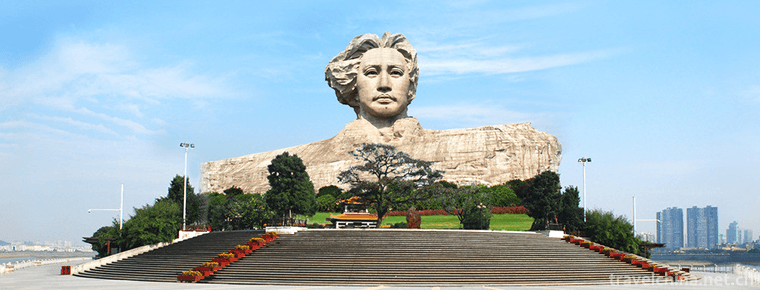
-
The Bund
The Bund, located on the Huangpu river bank in Huangpu District, Shanghai.
Views: 160 Time 2018-10-12 -
China Railway HighSpeedCRH
China Railway High-Speed (CRH) has two meanings: the technical standard of China High-Speed refers to the passenger dedicated line railway with 250 km/h .
Views: 151 Time 2018-11-13 -
The Twin Colossals
Shuangta Mountain is located ten kilometers southwest of Chengde Summer Resort in Hebei Province, with a total area of 3000 hectares and beautiful scenery. It is the largest natural scenic resort in C.
Views: 285 Time 2019-02-08 -
Weihai Tianmu Hot Spring Resort
Tianmu Hot Spring Resort Project invested 600 million yuan by Zhuhai Tianmu Group. A total of 35,000 square meters were opened in September 2008..
Views: 80 Time 2019-02-22 -
Weishan Lake National Wetland Park
Weishan Lake National Wetland Park, located in the southern part of Weishan County, Jining City, Shandong Province, is less than 3 kilometers away from the urban area..
Views: 195 Time 2019-02-22 -
Yinghu Scenic Area
Yinghu, a national AAAA-level tourist area, is located 16 kilometers southwest of Ankang City, Shaanxi Province. The total area is 102.8 square kilometers, including 77 square kilometers.
Views: 163 Time 2019-03-05 -
Cooking Skills of Confucian Cuisine
The cooking skill of Confucian cuisine, the traditional handicraft of Qufu City, Shandong Province, is one of the national intangible cultural heritages..
Views: 97 Time 2019-05-09 -
Li Folk Songs
Folk songs play an important role in daily life. Almost all men, women and children can sing. Especially on festive days, singing is an indispensable recreational activity. In the daily production wor.
Views: 307 Time 2019-05-12 -
Herbal tea
Herbal tea is the general name of traditional Chinese herbal medicinal plant beverage. Guangdong herbal tea is the representative of traditional Chinese herbal tea culture. Herbal tea is a kind of bev.
Views: 193 Time 2019-05-13 -
Sun Bin quan
Sun Bin Quan is an ancient and rare traditional boxing in Shandong Province. Its connotation is broad and profound, which was created by Sun Bin, a military strategist in the Spring and Autumn Period .
Views: 162 Time 2019-06-17 -
Ban Zhao
Ban Zhao (about 45 years - about 117 years), also known as Ji, the word Hui ban. Fufeng An Ling (now northeast of Xianyang, Shaanxi), a historian and a writer of Eastern Han Dynasty. historian Ban Bi .
Views: 287 Time 2019-09-11 -
Dazhou climate
Dazhou city belongs to subtropical humid monsoon climate type. Due to the complex topography, regional climate differences are large. The low mountains, hills and river valleys with an altitude of 800 meters have mild climate, warm winter, early sprin.
Views: 384 Time 2020-12-20

